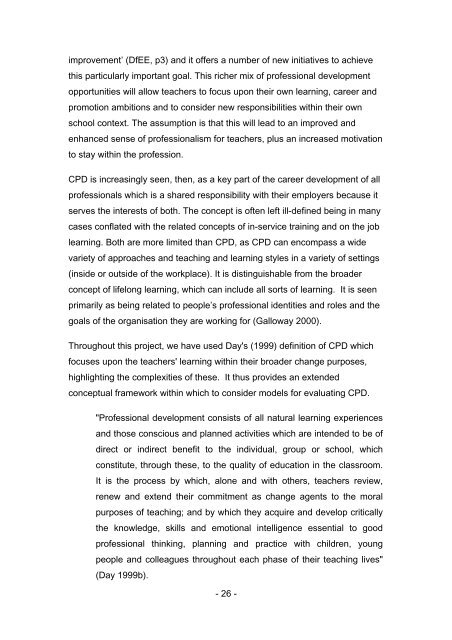Evaluating the Impact of Continuing Professional Development (CPD)
Evaluating the Impact of Continuing Professional Development (CPD)
Evaluating the Impact of Continuing Professional Development (CPD)
Create successful ePaper yourself
Turn your PDF publications into a flip-book with our unique Google optimized e-Paper software.
improvement’ (DfEE, p3) and it <strong>of</strong>fers a number <strong>of</strong> new initiatives to achieve<br />
this particularly important goal. This richer mix <strong>of</strong> pr<strong>of</strong>essional development<br />
opportunities will allow teachers to focus upon <strong>the</strong>ir own learning, career and<br />
promotion ambitions and to consider new responsibilities within <strong>the</strong>ir own<br />
school context. The assumption is that this will lead to an improved and<br />
enhanced sense <strong>of</strong> pr<strong>of</strong>essionalism for teachers, plus an increased motivation<br />
to stay within <strong>the</strong> pr<strong>of</strong>ession.<br />
<strong>CPD</strong> is increasingly seen, <strong>the</strong>n, as a key part <strong>of</strong> <strong>the</strong> career development <strong>of</strong> all<br />
pr<strong>of</strong>essionals which is a shared responsibility with <strong>the</strong>ir employers because it<br />
serves <strong>the</strong> interests <strong>of</strong> both. The concept is <strong>of</strong>ten left ill-defined being in many<br />
cases conflated with <strong>the</strong> related concepts <strong>of</strong> in-service training and on <strong>the</strong> job<br />
learning. Both are more limited than <strong>CPD</strong>, as <strong>CPD</strong> can encompass a wide<br />
variety <strong>of</strong> approaches and teaching and learning styles in a variety <strong>of</strong> settings<br />
(inside or outside <strong>of</strong> <strong>the</strong> workplace). It is distinguishable from <strong>the</strong> broader<br />
concept <strong>of</strong> lifelong learning, which can include all sorts <strong>of</strong> learning. It is seen<br />
primarily as being related to people’s pr<strong>of</strong>essional identities and roles and <strong>the</strong><br />
goals <strong>of</strong> <strong>the</strong> organisation <strong>the</strong>y are working for (Galloway 2000).<br />
Throughout this project, we have used Day's (1999) definition <strong>of</strong> <strong>CPD</strong> which<br />
focuses upon <strong>the</strong> teachers' learning within <strong>the</strong>ir broader change purposes,<br />
highlighting <strong>the</strong> complexities <strong>of</strong> <strong>the</strong>se. It thus provides an extended<br />
conceptual framework within which to consider models for evaluating <strong>CPD</strong>.<br />
"Pr<strong>of</strong>essional development consists <strong>of</strong> all natural learning experiences<br />
and those conscious and planned activities which are intended to be <strong>of</strong><br />
direct or indirect benefit to <strong>the</strong> individual, group or school, which<br />
constitute, through <strong>the</strong>se, to <strong>the</strong> quality <strong>of</strong> education in <strong>the</strong> classroom.<br />
It is <strong>the</strong> process by which, alone and with o<strong>the</strong>rs, teachers review,<br />
renew and extend <strong>the</strong>ir commitment as change agents to <strong>the</strong> moral<br />
purposes <strong>of</strong> teaching; and by which <strong>the</strong>y acquire and develop critically<br />
<strong>the</strong> knowledge, skills and emotional intelligence essential to good<br />
pr<strong>of</strong>essional thinking, planning and practice with children, young<br />
people and colleagues throughout each phase <strong>of</strong> <strong>the</strong>ir teaching lives"<br />
(Day 1999b).<br />
- 26 -

















